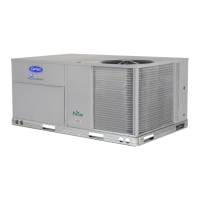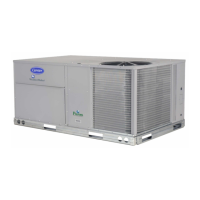92
Heating Dehumidification Reheat Mode
This mode is used when dehumidification is required and heat-
ing is required, such as when the outside air is at a low tem-
perature but high humidity exists. The system operates the
same as in the Venting Dehumidification mode but the dis-
charge air is reheated to the SASP HEAT set point. Note that
the Humidi-MiZer system is only intended to supply neutral
temperature air and has minimal heating capacity. It will only
be able to reheat to a heating set point at moderate outside air
temperatures and/or low airflows. If dehumidification and re-
heat to a heating temperature is truly required, a staged, modu-
lating gas, hydronic, or third party heat unit should be used.
System Control
The essential difference between the Cooling Dehumidification,
Venting Dehumidification, and Heating Dehumidification modes
is in the supply air set point. See Table 72. In Cooling Dehumidifi-
cation mode, the supply air set point is the temperature required to
provide cooling to the space. This temperature is whatever the
cooling control point would have been in a normal cooling mode.
In Venting Dehumidification mode, the supply air set point will be
either an offset subtracted from return air temperature (D.V.RA) or
the Vent Reheat Set Point (D.V.HT). Both values are configurable.
In Heating Dehumidification mode, the supply air set point is
whatever the heating control point would have been in a normal
heating mode. For all modes, the unit compressor staging will de-
crease the evaporator discharge temperature to the Dehumidify
Cool Set Point (D.C.SP COOL) in order to meet the latent load
and reheat the air to the required cooling or reheat set point. There
is a thermistor array called Temperatures
AIR.T
CCT con-
nected to the RCB. This thermistor array serves as the evaporator
discharge temperature (EDT). See Fig. 15.
The P-Series Humid-MiZer
®
system uses refrigerant flow modu-
lation valves that provide accurate control of the leaving air tem-
perature as the evaporator discharge temperature is decreased to
meet the latent load. As the refrigerant leaves the compressor, the
modulating valves vary the amount of refrigerant that enters and/
or bypasses the condenser coil. As the bypassed and hot refriger-
ant liquid, gas or two-phase mixture passes through the Humidi-
MiZer coil, it is exposed to the cold supply airflow coming from
the evaporator coil. The refrigerant is subcooled in this coil to a
temperature approaching the evaporator leaving air temperature.
The liquid refrigerant then enters a thermostatic expansion valve
(TXV) where the refrigerant pressure is decreased. The refrigerant
enters the TXV and evaporator coil at a temperature lower than in
standard cooling operation. This lower temperature increases the
latent capacity of the evaporator. The refrigerant passes through
the evaporator and is turned into a superheated vapor. The air
passing over the evaporator coil will become colder than during
normal operation. However, as this same air passes over the Hu-
midi-MiZer reheat coil, it will be warmed to meet the supply air
set point temperature requirement. See Fig. 16.
Fig. 15 — Humidi-MiZer
®
System Control
Fig. 16 — Humidi-MiZer
®
System Diagram
Evaporator Discharge Temperature
In Subcool or Reheat Mode, compressor staging
and increased subcooling drives evaporato
discharge temperature down to meet higher latent
loads
irflo
EVAPORATOR
HUMIDI-MIZER ADAPTIVE
DEHUMIDIFICATION
SYSTEM COIL
Supply Air Temperature Control
Innovative algorithm to control supply air temperature
modulates flow bypass to meet desired supply air setpoint -
no overcooling or overheating of the space.
Subcooling Mode: Meet Cooling Mode Supply Air Setpoint
Reheat Mode: Meet Return Air Offset or Reheat Setpoint (configurable)
CCT
SAT
D.C.SP COOL
RAT-D.V.RA or
D.V.HT
3
4
EXPANSION
INDOOR AIR
EVAPORATOR
5
5'
EVAPORATOR
REHEAT HX
EXPANSION
DEVICE
4'
3'
CHECK VALVE
3-WAY VALVE
3a'
2'
2a'
BYPASS
MODULATING
VALVE
CONDENSER
OUTDOOR AIR
CONDENSER
MODULATING
VALVE
1'
COMPRESSOR
1
2
CONDENSER
OUTDOOR AIR
COMPRESSOR
CIRCUIT B
CIRCUIT A

